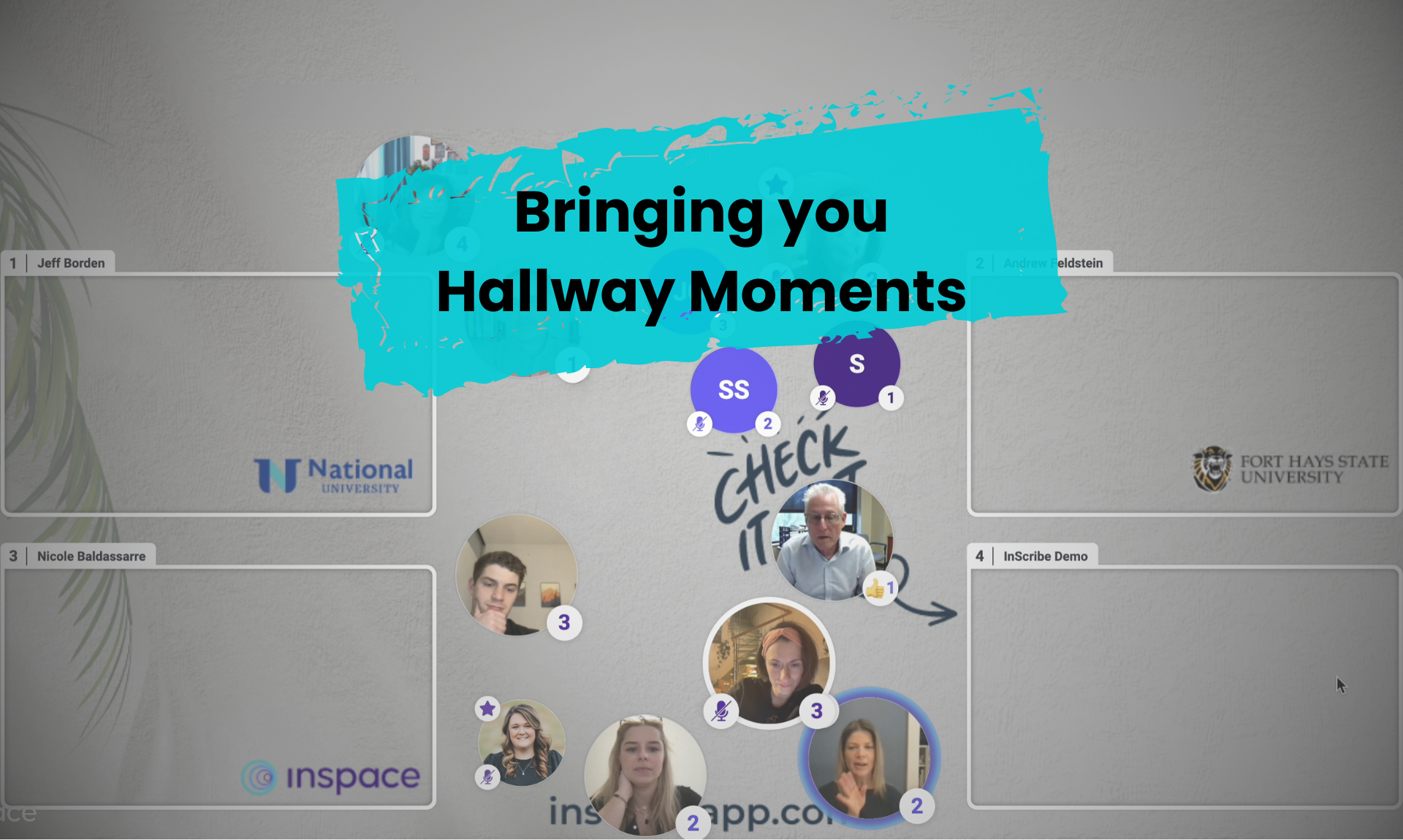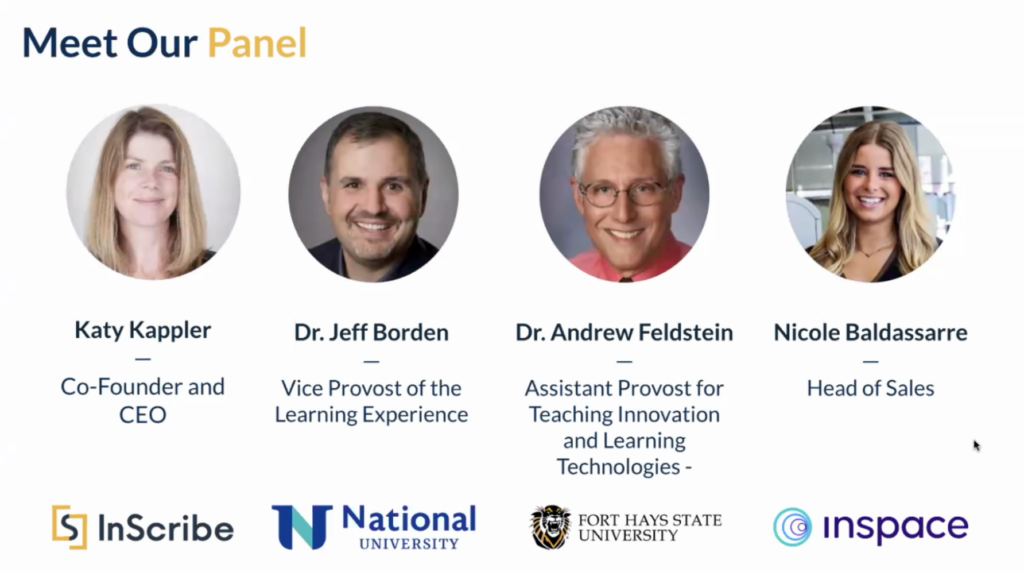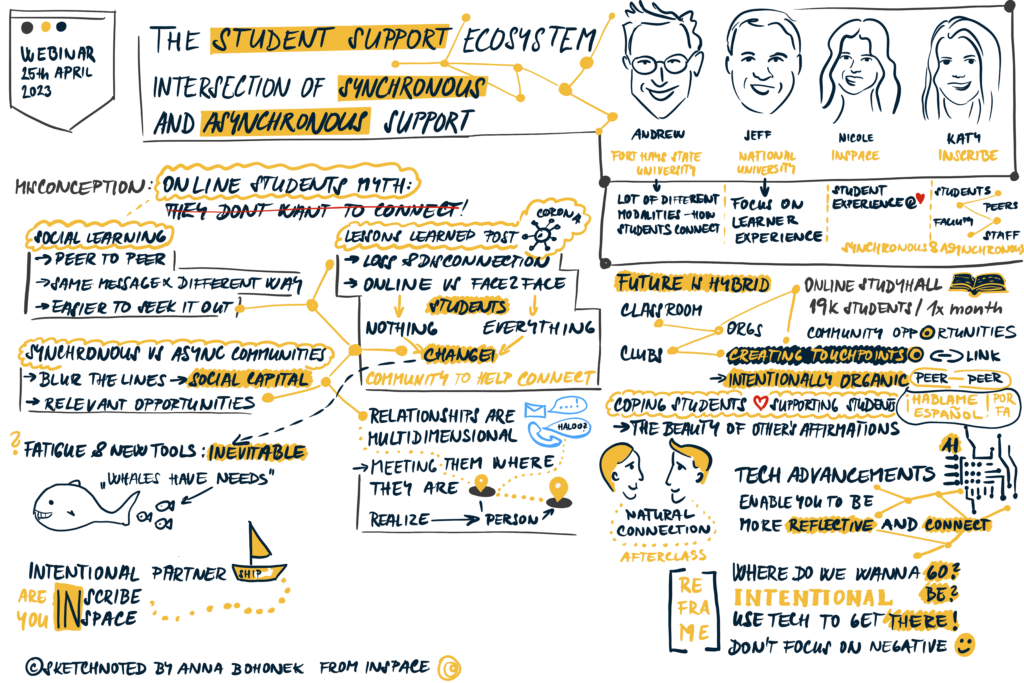
Peer-to-Peer Engagement and the Intersection of Synchronous and Asynchronous Student Support in Higher Ed
Insights on using technology to support peer-to-peer engagement and create unified learner experiences in both synchronous and asynchronous contexts for non-traditional and online students
On April 25, 2023, InSpace partner InScribe hosted a panel discussion on the student support ecosystem, focusing on peer-to-peer engagement and how to use technology to support it in synchronous and asynchronous student contexts. The discussion focused on non-traditional and online students but touched on all teaching and learning modalities.
InScribe co-founder and CEO Katie Kappler hosted the virtual conversation about the future of peer-to-peer engagement.
Panelists included:
- Dr. Jeff Borden, Vice Provost of Learning Experience at National University
- Dr. Andrew Feldstein, System Provost for Teaching Innovation and Learning Technologies at Fort Hays State University
- Nicole Baldassarre, Head of Sales, InSpace Proximity

The value of peer-to-peer connections for online learners
Dr. Borden began by sharing, “There are contexts in which peer-to-peer engagement is less effective, often when it’s required. For instance, traditional LMS discussions may not always be meaningful in terms of learning. Students may feel that their peers are less knowledgeable and not value their opinions.”
He cited Bandura’s ideas on social learning to support the idea that observing a modeled experience from another knowledgeable person can be beneficial: “InScribe provides a platform for these kinds of experiences. Students can learn from their peers, who may be more advanced in a specific topic area, and the platform is especially useful in subjects like math and writing.”
Additionally, he finds that “InScribe allows students to hear a different perspective or language, which can be a reinforcement or present new insights. Sometimes, hearing the same message but spoken in a different way can make all the difference.”
Dr. Feldstein considered Fort Hays’ response to the COVID-19 pandemic in his response. His office surveyed on-campus and online students about their experiences, and an “open-ended question in the survey revealed an interesting gap. One group of students expressed feelings of loss, disconnection, depression, lack of motivation, and isolation. In contrast, another group stated that nothing much had changed, and everything was pretty much the same as it had always been. The first group consisted of face-to-face students who had been transitioned off-campus, while the second group were online students.”
Dr. Feldstein continued, “At first, we were relieved to hear that nothing had changed for the online students. But then we realized that this response indicated we had been underserving our online students for a long time by not helping them make the types of connections that face-to-face students naturally have. Online students lacked the opportunities to connect with their peers in the same way.”
This realization led to initiatives with InScribe and InSpace to build student communities that weren’t connected to specific courses, but instead offered spaces for students to connect naturally with each other. Dr. Feldstein said, “This approach has proven to be extremely powerful, and we have seen a lot of positive traction.”
Baldassarre built on these points by referencing a paper published by the University of Miami, Ohio, which examined the sense of community among asynchronous and synchronous online students. The study found that asynchronous students felt more connected to the institution during one-on-one interactions with faculty members, such as during office hours. On the other hand, synchronous students craved more peer connections outside of scheduled class times in order to feel a sense of community.
The irony, Baldassarre said, “is that in asynchronous programs, students don’t necessarily have a built-in cohort to rely on for connections and opportunities when seeking career advancement. At InSpace, we’re trying to blur the lines between async and sync to build social capital for students. We want them to feel good about not only the quality of their academic experience but also the quality of the relationships they formed during their time at the university.”
Baldassarre called for increased attention to context and relevance when designing connection opportunities for online students: “We should aim for deeper, more meaningful areas for connection, which can be challenging across time zones in online programs. Moving forward, it’s about creating valuable opportunities for students, considering that everyone is busy. We need to ensure that these opportunities are worth attending.”
Ecosystems create unified learner experiences
In speaking about learner modalities and student relationships with institutions and individual faculty, it’s helpful to understand how social presence is established.
Our panelists suggested that establishing social presence in learning is challenging but essential. Without the connections and trust, the learning experience will not be comfortable or effective.
Dr. Feldstein explained, “Often, we provide students with just one way to connect, like course discussion boards, but this can sometimes feel artificial. We want to give students the ability to connect on their own terms, either asynchronously or synchronously […] Having the choice of how and when to connect, as well as understanding when it’s appropriate to use different methods, creates various opportunities for students to connect, rather than limiting them to just one way of communication.
Dr. Borden added that the ecosystem approach “provides a curated set of choices for specific communication events, instead of an overwhelming all-channel system. This allows for meaningful interactions at the right time with the right person, which is crucial for fostering connections.”
He said it shouldn’t be surprising that students want to connect with others, especially when they can interact with peers from different sections of the same course, promoting peer learning and enriching their educational experience.
One crucial piece of support for peer-to-peer connections on campus is intentionally viewing students as whole individuals, not as class members or financial aid recipients. Dr. Borden added, “Students have cognitive, emotional, social, and pragmatic needs, all of which can influence their decision to stay in school or leave. While we typically measure academic success in terms of grades and attendance, we could also measure the connections students make, the help they receive and offer, and their sense of purpose and motivation. Addressing these aspects could significantly improve student persistence and success.”
Practical ideas for increasing student connections
Dr. Borden shared an anecdote about National’s new president, Dr. Mark Miller, who previously worked at WVU. While Dr. Miller was at WVU, they had an online study hall available to students. Out of the 24,000 full-time students in his School of Education, 19,000 accessed the online study hall at least once a month. He added, “As we think about creating an ecosystem, we’re looking at ways to put community front and center for our students, rather than just offering access to a portal and an LMS.”
Why? “An LMS is an important component of a digital classroom, but it doesn’t encompass the entirety of online learning. By integrating tools like InSpace and InScribe throughout the student experience, we’re able to provide access to clubs, organizations, private tutoring sessions, peer tutoring, and more. Students can communicate with others in their departments using synchronous or asynchronous tools, fostering knowledge management,” said Borden. “By creating multiple touchpoints across various contexts within the school, we can make a significant difference in the overall student experience.”
Dr. Feldstein described the impact of the Tiger-Tiger community at Fort Hays: “Students have made incredible, meaningful connections, some of which are related to their studies. The asynchronous aspect allows for ongoing discussions without needing to be present in that moment.”
He related a story about one powerful conversation that took place when a student posted with the subject, “Maybe I’m too old.” She discussed her struggles and wondered if she shouldn’t continue. The amount of support from other students was overwhelming, with some sharing their own experiences and encouraging her to keep going. Within a week, over 330 students viewed that post. He added, “You believe that the persistence of the post and the ability to have those conversations, receiving instantaneous affirmation from fellow students, made a real difference for many.”
Third Side Pedagogy
Dr. Feldstein brought up another benefit of peer-to-peer connection on campus. At Fort Hays, he said, they intentionally designed the system so that not everything needs to be the faculty’s responsibility. He stated, “We are trying to emulate the third side pedagogy, which includes the interactions that naturally occur among students before and after class, without the need for faculty facilitation.”
In a face-to-face environment, students can connect with each other, find others who may be struggling with the same concepts, and work together to figure things out. These connections and conversations happen naturally, outside of the instructor’s purview.
Feldstein added, “With the InScribe community and the addition of synchronous components through InSpace, we aim to create similar opportunities for online students. This way, they can make connections and engage with their peers just as easily, if not more easily, than face-to-face students when they meet up after class.”
Baldassarre shifted the conversation to AI and the excitement in education around advancements in AI and machine learning. She stressed the importance of reframing AI and considering how it can bridge gaps while still focusing on human-centered elements.
She said, “In the case of InSpace, we aim to keep the human front and center in the online experience while minimizing cognitive load and administrative functions. For example, AI can be used to record transcripts, freeing us up to be more reflective in conversations and focus on commonalities.”
Baldassarre added, “This is also an exciting time for personalized learning at institutions. With a peer-to-peer lens, it’s now easier than ever to connect students with similar interests. We can surface insights and nudges, allowing students to self-select and build bonds with their peers based on shared interests. […] We can expect exciting developments in community building and connection by combining AI with human-focused, value-added activities for synchronous time while reducing the burden of administrative tasks.”
Dr. Feldstein added, “It’s not just about the technology itself. At the end of the day, it’s about where we want to go and what we want to achieve in higher education. We need to use technology to help us reach our goals rather than being led by it.”
The primary aim, he said, is to engage students and encourage their curiosity and participation in the learning process. By using imagination and curiosity, institutions can determine how technology can help us reach our objectives.
Dr. Bordan agreed, stating that the key is to be intentional: “What excites me about today’s technology landscape is the increased intentionality. I feel for the provosts, presidents, and others from the 2000-2010 era who aimed for data-driven decisions but lacked good data and struggled to piece everything together. However, I encourage them to take another look, as some of these technologies are quite remarkable in their ability to intentionally connect people.”
Learn more about how InSpace is addressing challenges in the student support ecosystem.
